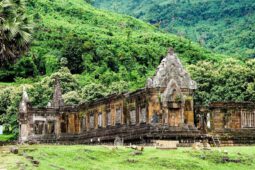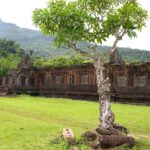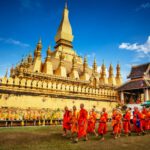Vat Phou (Wat Phu)
Vat Phou (or Wat Phu) is a ruined Khmer Hindu temple complex in southern Laos. It is located at the base of mount Phu kao, some 6km (3.7 mi) from the Mekong in Champasak Province. There was a temple on the site as early as the 5th century, but the surviving structures date from the […]
Wat Phou is the oldest temple in Laos, it was recognized to be the World Heritage Site by UNESCO in 2001. This old temple has date in 5th century, had been Hinduism’s centre, dedicated to Shiva.

The Wat Phou is another name of “temple-mountain” due to its location at the base of Phu Kao mountain, overlooking the plains towards the Mekong river. In ancient Khmer, the mountain was named Lingaparvata which means “Linga Mountain”, because the pillar like stone formation on top resembles a linga, the representation of the Hindu God Shiva.
Fly over a thousand year of history, now is still ruins, but all of them reveal that Wat Phou is a religious architecture complex, a place keeping Laos’ cultural and historic values. The temple main entrance and front side are still remain the vestige of relievos carved Hinduism gods.
Structure
The various structures of the Wat Phou are built on seven terraces, aligned on an axis from the Mekong river bank towards the mountain. Starting at the river bank the visitor finds a long processional walkway, two palaces and finally the main sanctuary.
Halfway the walkway are the remains of two palaces, the Ho Thao South of the processional walkway and the Ho Nang to the North. Although called palaces, their function is not known with certainty. It is believed that the 11th century buildings were used during Hindu ceremonies. The lintels and pediments on the two large buildings are adorned with intricate carvings of Gods and mythological creatures like Shiva and his consort Uma on Nandi, the sacred bull. Near the South palace is a shrine dedicated to the sacred bull Nandi, the mount of Shiva. Between the palaces and the main sanctuary are the remains of several structures, including six small brick towers that used to contain a linga on the 4th terrace and a Dvarapala guardian on the second terrace.
Festival
On the full moon during the third lunar month every year, Wat Phou festival is held in three days, it is locally called Boun Wat Phou Champasak. This is the Buddhist festival of southern Laos, one of the biggest one in the country which attracts everyone including northeast Thai people. These days, Laos people flock to the grounds of the Wat Phou temple to pay respect to the Buddha and bring offerings. The grounds are filled with food and drink stalls, there are traditional Laos dance and musical performances, games and other entertainment.




